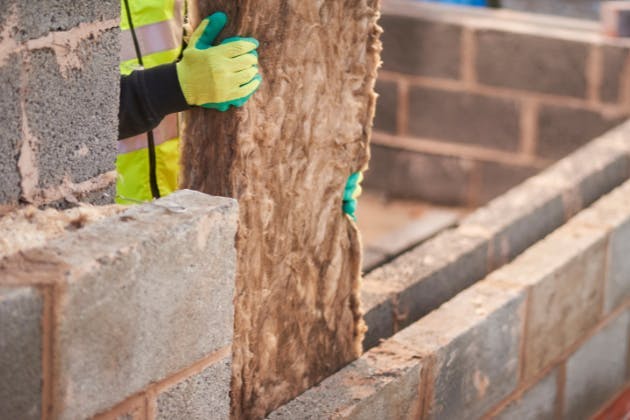Cavity wall insulation is a critical component in enhancing a home's energy efficiency and reducing heating costs. Whether you're a new homeowner or simply looking to improve your property's thermal performance, this guide will equip you with the essential information to make informed decisions about your home's insulation.
To find out more about cavity wall insulation, get in touch with our experts at 01639 790426 or 07852 229017 or by filling in our online contact form.

What are Cavity Walls?
Cavity walls are a common construction method in buildings, particularly those built after the 1920s. They consist of two separate walls, known as 'leaves', with a gap or cavity between them. The outer leaf is typically made of brick, while the inner leaf can be brick, concrete block, or another material. This cavity serves as a barrier against moisture penetration and can be filled with insulation to improve the building's thermal efficiency.
What is Cavity Wall Insulation?
Cavity wall insulation is a method of improving a building's energy efficiency by filling the gap between the inner and outer leaves of a cavity wall with insulating material. This process significantly reduces heat loss through the walls, leading to lower energy bills and improved comfort within the property.
Common materials used for cavity wall insulation include:
- Mineral wool: Made from recycled glass or stone, this fibrous material is blown into the cavity.
- Polystyrene beads: Small, foam-like beads that are pumped into the cavity and then bonded together.
- Polyurethane foam: A liquid foam that expands to fill the cavity, providing excellent insulation properties.
Each material has its own benefits and considerations, and the choice often depends on the specific characteristics of the property and the cavity itself.
How to Identify Cavity Walls
Check the Age of Your Property
Properties built after the 1920s are likely to have cavity walls, as this construction method became increasingly popular during this period. Houses built after the 1990s are even more likely to have cavity walls and may have had insulation installed during construction due to updated building regulations.
Examine the Brickwork Pattern
The brick pattern on external walls can provide valuable clues about the wall construction:
- Cavity walls typically display a uniform pattern of bricks laid lengthwise, known as 'stretcher bond'.
- Solid walls often show a more varied pattern, with both lengthwise and crosswise bricks visible, known as 'English bond' or 'Flemish bond'.
Measure the Wall Thickness
To measure wall thickness, focus on an external wall where it meets a window or door frame:
- Open the window or door fully.
- Measure from the outside wall surface to the inside edge of the window or door frame.
If the measurement exceeds 300mm (or 26cm), you likely have a cavity wall. Solid walls are typically thinner, around 225mm (or 22cm).
Look for External Signs
Examine the external walls for:
- Air bricks or vents: These are small, perforated bricks that allow air circulation within the cavity.
- Small holes or boreholes: These may be visible in the mortar joints, typically about 1cm in diameter and spaced at regular intervals. These are often indicators that cavity wall insulation has been retrofitted.
How to Check if Cavity Wall Insulation is Already Installed
Use Your Energy Performance Certificate (EPC)
An EPC provides valuable information about a property's energy efficiency:
- Obtain your EPC: If you don't have a copy, you can retrieve it from the official EPC Register website.
- Locate the 'Walls' section: This will specify the wall type and whether insulation is present.
- Check the recommendations: If cavity wall insulation is suggested, likely, your walls are not currently insulated.
Visual Inspection
Look for these signs that may indicate the presence of cavity wall insulation:
- Small, evenly spaced holes in the external walls, often filled with mortar of a slightly different colour.
- Drill holes near the damp-proof course (about 1m above ground level) and below the eaves on each floor.
- Patches of different coloured mortar, which may indicate where insulation has been injected.
Professional Inspection
If you're unsure about the presence of cavity wall insulation, consider hiring a professional to conduct a borescope inspection. This involves:
- Drilling a small hole in the external wall.
- Inserting a borescope (a thin, flexible camera) to visually inspect the cavity.
- Determining whether insulation is present and assessing its condition.
This method provides a definitive answer and can also identify any issues with existing insulation.
Potential Problems with Cavity Wall Insulation
While cavity wall insulation can offer significant benefits, poorly installed or inadequate insulation can lead to problems:
- Moisture penetration: If the insulation becomes saturated, it can bridge the cavity and allow moisture to penetrate the inner leaf, leading to damp issues.
- Cold spots: Uneven distribution of insulation can result in areas of the wall remaining colder, potentially leading to condensation and mould growth.
- Structural damage: In severe cases, moisture trapped in the cavity can cause frost damage to brickwork or affect the wall ties that hold the two leaves together.
- Blocked air bricks: Incorrectly installed insulation may obstruct air bricks, reducing ventilation and potentially leading to indoor air quality issues.
To mitigate these risks, always use a certified installer and ensure a thorough survey is conducted before installation. Regular inspections of your walls can help identify any developing issues early, allowing for prompt remediation.
Cavity Wall Insulation FAQs
Q: Is cavity wall insulation suitable for all properties?
A: No. Properties in areas with high wind-driven rain exposure, those with pre-existing damp issues, or buildings with poorly maintained brickwork may not be suitable. A professional survey is essential to determine suitability.
Q: Can cavity wall insulation cause damp problems?
A: While properly installed insulation shouldn't cause dampness, poor installation or unsuitable properties can lead to moisture issues. Regular inspections and promptly addressing any signs of damp promptly are crucial.
Q: How long does cavity wall insulation last?
A: High-quality cavity wall insulation can last for 25 years or more. However, its effectiveness can decline over time, particularly if exposed to moisture or if the property settles, causing gaps in the insulation.
Q: What's the difference between cavity wall insulation and external wall insulation?
A: Cavity wall insulation fills the gap between the inner and outer walls, while external wall insulation involves adding an insulating layer to the outside of the property. The latter is typically used for solid-walled properties or when cavity insulation is unsuitable.
Q: How much can I save on energy bills with cavity wall insulation?
A: Savings vary depending on your property size and heating habits, but the Energy Saving Trust estimates that cavity wall insulation can save up to £275 per year on heating bills for a typical semi-detached house.
Contact our cavity wall insulation specialists
For all your cavity wall insulation questions and needs, please get in touch with the team at Cavi Clear at 01639 790426 or 07852 229017 or by filling in our online contact form. We work throughout South Wales, Swansea, Cardiff, Bristol, and nearby areas.


